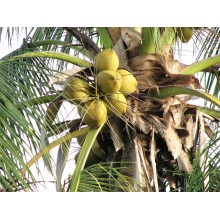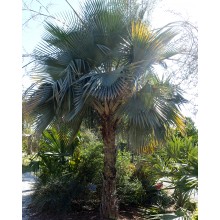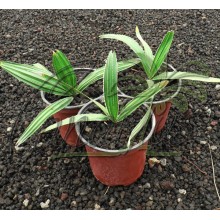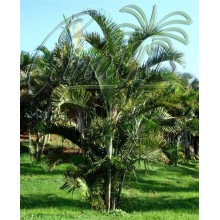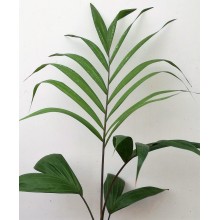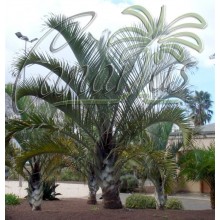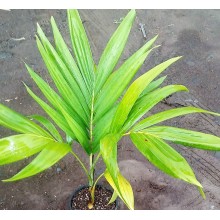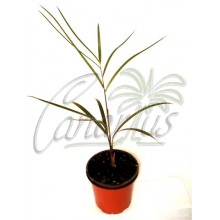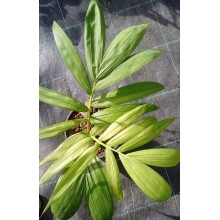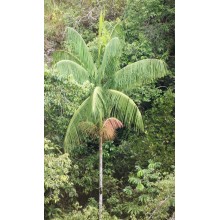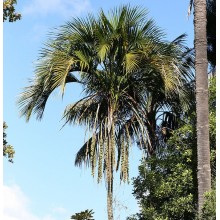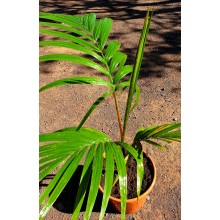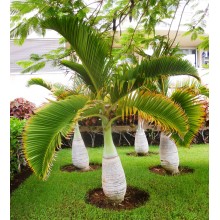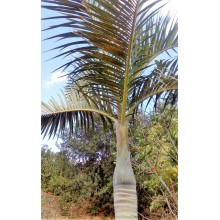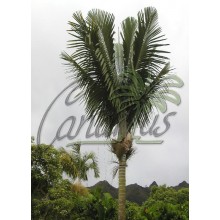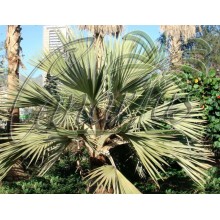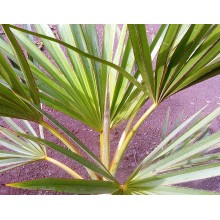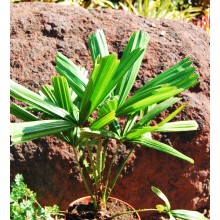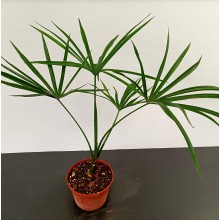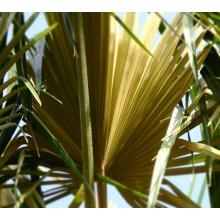Palms There are 97 products.

The palm family, Arecaceae or Palmae, includes about 2.400 species, native to warm climates of the world, ranging from delicate tropical species to cold hardy palms. Some palms can be planted outdoors in Central Europe and stand hard freezes, well below -10 ºC (14 F). Those who live in Mediterranean countries can grow a larger number of species outdoors. Some growers in coastal Southern Europe are now raising outdoor collections of palms containing more than 100 species.
Canarius will only ship robust palms, grown in small pots to reduce shipping costs and handling problems. So transplant them to larger pots shortly after you receive the package. Be prepared to give them the best. Some palms can take snow, some can live indoors or in pots, and some are very tropical. Just choose one that can thrive in your conditions.
What palms can grow in your area? Read our list of Cold Resistant Palms for Europe. Visit Canarius blog and learn more about our palms. You will see pictures from the nurseries: different types of New Zealand Palms, Bottle Palms with superior root quality.
-
Cocos nucifera 'Yellow Tall'
Cocos nucifera 'Yellow Tall'
The coconut palm needs no introduction. It is simply "The Tree of Life". Here we offer a stout plant sprouted about 2 years ago.
84,00 € -
Copernicia hospita
Copernicia hospita
Copernicia is a palm which is endemic to Cuba.The fan-shaped leaves are 1.5 to 2 m wide and are wedge-shaped circular. They are divided into many rigid segments. The ends of the segments are slightly hanging.
42,20 € -
Copernicia rigida 15-20 cm - Cont. 14 cm - 3 years
Copernicia rigida 15-20 cm - Cont. 14 cm - 3 years
10-15 cm - Cont. 12 cm - 2 years. Unusual palm with wedge-shaped upright leaves. Copernicia rigida is native to Cental-Eastern Cuba, in serpentine savanna or scrub.Trunk is gray, up to 15 m (50 ft) tall with a dense compact crown of stiff, erect, wedge-sh
36,70 € -
Dypsis cabadae
Dypsis cabadae
Clumping palm with bamboo-like green, ringed stems. It is reminiscent of Dypsis lutescens but all parts are dark green and fruits are small and red.
32,50 € -
Dypsis decaryi
Dypsis decaryi
The "triangle palm" has a striking leaf arrangement. It is a fast-growing feather palm from the drier and cooler South of Madagascar, that is becaming increasingly popular in cultivation.
38,60 € -
Dypsis pembana LARGE
Dypsis pembana LARGE
Easy and fast growing clumping palm with lush feather foliage.
49,30 € -
Dypsis plumosa
Dypsis plumosa
Fast and easy, medium sized palm from Madagascar, with plumose feather leaves and grey-green ringed trunk. It was known in cultivation as "Dypsis sp. Fine Leaf" and it was named Dypsis plumosa in 2009.
36,60 € -
Dypsis prestoniana
Dypsis prestoniana
Uncommon, mid to large, solitary palm native to South Madagascar, where less than 200 specimens still live in the wild.
46,50 € -
Howea belmoreana
Howea belmoreana
Elegant kentia palm from the Lord Howe Island. Howea belmoreana is the rarer sister of the enormously common "common kentia", Howea forsteriana, which is produced by millions units as the perfect house plant. Howea belmoreana is similar in many aspects but its leaves arch in the opposite sense and its segments point upwards.
46,50 € -
Hyophorbe indica 'Red'
Hyophorbe indica 'Red'
This palm is a great ornamental. It is very beautiful as a juvenile because of the reddish stem and petioles. They are very fast when young.
46,20 € -
Hyophorbe lagenicaulis - Bottle Palm
Hyophorbe lagenicaulis - Bottle Palm
h= 30-60 cm - Cont. 14-16 cm. Distinctive small palm, with a grey bottle-shaped trunk. Hyophorbe lagenicaulis has a waxy green crownshaft and elegant, arching pinnate leaves. Be careful, it is damaged or killed by frost, nevertheless it is a naturally short species that can live for years in a container.
62,30 € -
Hyophorbe verschaffeltii - Large
Hyophorbe verschaffeltii - Large
Popular tropical palm with smooth grey ringed trunk, a robust grey-green crownshaft, and stiffly ascending, pinnate leaves.
50,80 € -
Kentiopsis oliviformis
Kentiopsis oliviformis
It is one of the stoutest and most cold-hardy New Caledonian palms. Kentiopsis oliviformis is a must for collectors, with erect feather leaves and a stout ringed trunk.
61,50 € -
Latania lontaroides
Latania lontaroides
Beautiful palm native to the Mascarene Islands. They have stiff fan shaped leaves, that become red during youth. They make excellent pot plants for decades and they are very easy to grow, but they are frost sensitive.
60,00 € -
Latania verschaffeltii LARGE
Latania verschaffeltii LARGE
Yellow Latan Palm. Yellow colour is eyecatchy juvenile palms, as they can turn very yellow, especially in cool sunny weather.
49,30 € -
Licuala spinosa
Licuala spinosa
This is the hardiest species in the genus Licuala, resistant to drought, wind, coastal conditions and short light frosts. It is a clumping palm from SE Asia. Its leaves are fantastic, glossy pinwheels.
72,00 € -
Livistona benthamii
Livistona benthamii
This species is smaller than other livistonas, with glossy drooping segments, reminiscent of the more common, and much larger, Livistona decora.
43,00 € -
Livistona fulva
Livistona fulva
Livistona fulva is a palm species, restricted in distribution to the Blackdown Tablelands in central Queensland, Australia. Livistona fulva is a tall solitary palm. In nature, it grows in open forests; in cultivation. it prefers a warm temperate climate and sunny position.
26,60 €
At the moment there are few products in this category Palms
















